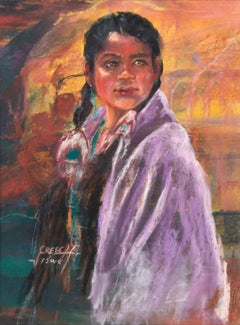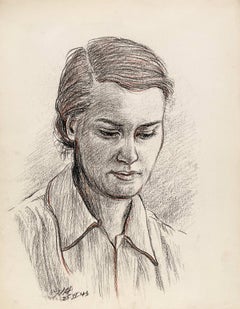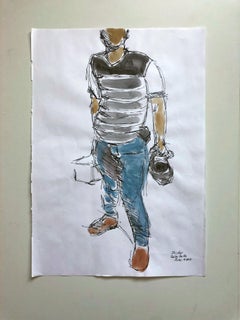Victoria Creech Stewart Art
to
1
Overall Width
to
Overall Height
to
1
1
1
1
1
1
1
1
10,042
2,758
1,381
1,375
1
Artist: Victoria Creech Stewart
'Portrait of a Young Navajo', Native American, Arizona, California Woman artist
By Victoria Creech Stewart
Located in Santa Cruz, CA
Signed lower left 'Creech PSWC' and created circa 1975
A compelling pastel study showing the subject dressed in brightly-colored ceremonial robes and gazing past the viewer. An eleg...
Category
1970s Victoria Creech Stewart Art
Materials
Pastel, Archival Paper
Related Items
An Intimate, 1940s Modern Portrait Drawing of a Young Woman by Harold Haydon
By Harold Haydon
Located in Chicago, IL
An Intimate, 1940s Modern Portrait Drawing of a Young Woman by Notable Chicago Artist, Harold Haydon (Am. 1909-1994). A finely drawn, introspective portrait in pastel and charcoal o...
Category
1940s American Modern Victoria Creech Stewart Art
Materials
Paper, Charcoal, Pastel
$85
H 14.5 in W 11.5 in D 0.13 in
Jaider Portrait. Watercolor, Ink and Pastel on Archival Paper.
By Celso José Castro Daza
Located in Miami Beach, FL
Drawing on paper is his basic work tool, some are sketches of his surviving works, others are sketches of moments he documents.
Undefined by medium, Celso Castro’s works each carry...
Category
2010s Contemporary Victoria Creech Stewart Art
Materials
Watercolor, Pastel, Paper, Ink
$400
H 19.5 in W 13.75 in D 0.1 in
Poncho Jueves 26 de Mayo, Framed Drawing
By Celso José Castro Daza
Located in Miami Beach, FL
Drawing on paper is his basic work tool, some are sketches of his surviving works, others are sketches of moments he documents.
Undefined by medium, Celso Castro’s works each carry...
Category
1990s Contemporary Victoria Creech Stewart Art
Materials
Pastel, Pencil, Paper
Carlos. Martes 24 de Mayo, Drawing
By Celso José Castro Daza
Located in Miami Beach, FL
Drawing on paper is his basic work tool, some are sketches of his surviving works, others are sketches of moments he documents.
Undefined by medium, Celso Castro’s works each carry...
Category
1990s Contemporary Victoria Creech Stewart Art
Materials
Pastel, Pencil, Paper
Untitled (Man in Blue Tank Top)
By Mark Beard
Located in New York, NY
Pastel and conté crayon with partial foil star on Rives BFK paper
Signed and dated, l.r.
This artwork is offered by ClampArt, located in New York City.
Mark Beard, born in 1956 in ...
Category
1970s Realist Victoria Creech Stewart Art
Materials
Foil
French 18th Century Pastel Portrait of a Young Lady in Period Costume.
Located in Cotignac, FR
Late 18th Century French pastel portrait on paper of a young lady in period dress in a 'feigned oval'. In gilt wood frame presented under glass.
Very much of its period and similar ...
Category
Late 18th Century Realist Victoria Creech Stewart Art
Materials
Paper, Crayon, Pastel
$1,341 Sale Price
37% Off
H 19.5 in W 15 in D 0.75 in
Revolutions, dynamic surreal purple drawing on paper of pretty girl dancing
By Patsy McArthur
Located in Dallas, TX
"Revolutions" is a dynamic and unique ink and pastel drawing on paper by Patsy McArthur showing a fashionable female figure dancing. The energy and movement makes it fun and whimsica...
Category
2010s Realist Victoria Creech Stewart Art
Materials
Pastel, Archival Paper, Ink
$2,320 Sale Price
20% Off
H 33.08 in W 25.2 in D 0.4 in
Contemporary Drawing "Blue Prayer" Draw, Pastel, Ink And Colored Pencils
Located in Bogotá, Bogotá
Drawing, pastel, Pencil, Petal Flowers, Color and Ink on Paper.
The base of this drawing is ordinary yellow paper of 80 gr. I use natural dyes from flowers, herbs, leaves, and tree ...
Category
2010s Contemporary Victoria Creech Stewart Art
Materials
Paper, Pastel, Ink, Pencil, Color Pencil
The Yellow Jacket, Portrait Painting
By Manuel Santelices
Located in Miami Beach, FL
Movies, TV and magazines are constant source of inspiration. Fame, as fleckring and shallow it can be sometimes, is very intriguing to him.
The worlds of fashion, society and pop cu...
Category
21st Century and Contemporary Contemporary Victoria Creech Stewart Art
Materials
Paper, Pastel, Ink
English School Portrait of a Woman
Located in Astoria, NY
English School, Portrait of a Woman, Charcoal and Pastel on Wove Paper, 19th Century, apparently unsigned, giltwood frame. Image: 10.75" H x 8.25" W; frame: 17" H x 14.5" W x 1" D. P...
Category
19th Century English School Victoria Creech Stewart Art
Materials
Paper, Charcoal, Pastel
Canray and BoisSec (figurative drawing, Creole musicians, rural, fiddle player)
By Susan Kiefer
Located in Kansas City, MO
Susan Kiefer
Canray and BoisSec
Pastel on paper
Year: 2004
Size: 19x25in
COA provided
Ref.: 924802-1664
Framed pastel portrait of beloved Creole musicians Canray Fontenot and BoisSe...
Category
Early 2000s Modern Victoria Creech Stewart Art
Materials
Paper, Pastel
$1,222 Sale Price
38% Off
H 19 in W 24 in D 0.35 in
'Suzanne', Large Mid Century French Portrait Drawing by Gourdon
Located in Cotignac, FR
French, Mid Century, pastel and crayon portrait of an elegant young lady by Gourdon. Signed and dated bottom left. Trade label to the back board. Presented in period deep 'tray' frame.
This seems to be an early work by the artist and hence it carries his name rather than his later more distinctive signature 'Aslan'. Alain Gordon was one of two brothers, his sibling Michel also went on to achieve notable success with his distinctive 'comic' style.
Alain Gourdon...
Category
Mid-20th Century Victoria Creech Stewart Art
Materials
Paper, Crayon, Pastel, Watercolor, Pencil
$826
H 28.5 in W 23.5 in D 2.25 in
Victoria Creech Stewart art for sale on 1stDibs.
Find a wide variety of authentic Victoria Creech Stewart available for sale on 1stDibs. You can also browse by medium to find art by Victoria Creech Stewart in archival paper, crayon, paper and more. Much of the original work by this artist or collective was created during the 1970s and is mostly associated with the modern style. Not every interior allows for large Victoria Creech Stewart, so small editions measuring 11 inches across are available. Customers who are interested in this artist might also find the work of Robert Andrew Parker, Winold Reiss, and Florence E. Nosworthy. Victoria Creech Stewart prices can differ depending upon medium, time period and other attributes. On 1stDibs, the price for these items starts at $2,750 and tops out at $2,750, while the average work can sell for $2,750.


